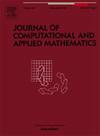Optimal error estimates of second-order weighted virtual element method for nonlinear coupled prey–predator equation
IF 2.1
2区 数学
Q1 MATHEMATICS, APPLIED
Journal of Computational and Applied Mathematics
Pub Date : 2025-03-06
DOI:10.1016/j.cam.2025.116617
引用次数: 0
Abstract
In this paper, we develop a numerical method for solving the nonlinear coupled prey–predator equation on arbitrary polygonal meshes, employing the virtual element method for spatial discretization and a second-order weighted method for temporal discretization. We rigorously establish the existence, uniqueness and convergence of solutions using Schaefer’s fixed point theorem. Moreover, we derive an optimal error estimate in the -norm that is independent of any spatial–temporal grid ratio constraints. This approach eliminates the need for the time semi-discrete system that would otherwise be introduced by temporal–spatial error splitting techniques, thereby streamlining the computational process. By adjusting the weighted parameter , the second-order weighted scheme seamlessly transitions to classic methods such as Crank–Nicolson () and two-step backward differentiation formula method (). Finally, numerical experiments confirm the validity of our theoretical results.
非线性耦合捕食-捕食方程二阶加权虚元法的最优误差估计
本文提出了一种求解任意多边形网格上非线性捕食者-猎物耦合方程的数值方法,采用虚元法进行空间离散,二阶加权法进行时间离散。利用Schaefer不动点定理,严格地建立了解的存在唯一性和收敛性。此外,我们在h1范数中导出了一个独立于任何时空网格比例约束的最优误差估计。这种方法消除了对时间半离散系统的需要,否则将由时空误差分割技术引入时间半离散系统,从而简化了计算过程。通过调整加权参数θ,二阶加权格式无缝过渡到经典方法,如Crank-Nicolson (θ=0.5)和两步后向微分公式法(θ=1)。最后,通过数值实验验证了理论结果的有效性。
本文章由计算机程序翻译,如有差异,请以英文原文为准。
求助全文
约1分钟内获得全文
求助全文
来源期刊
CiteScore
5.40
自引率
4.20%
发文量
437
审稿时长
3.0 months
期刊介绍:
The Journal of Computational and Applied Mathematics publishes original papers of high scientific value in all areas of computational and applied mathematics. The main interest of the Journal is in papers that describe and analyze new computational techniques for solving scientific or engineering problems. Also the improved analysis, including the effectiveness and applicability, of existing methods and algorithms is of importance. The computational efficiency (e.g. the convergence, stability, accuracy, ...) should be proved and illustrated by nontrivial numerical examples. Papers describing only variants of existing methods, without adding significant new computational properties are not of interest.
The audience consists of: applied mathematicians, numerical analysts, computational scientists and engineers.

 求助内容:
求助内容: 应助结果提醒方式:
应助结果提醒方式:


